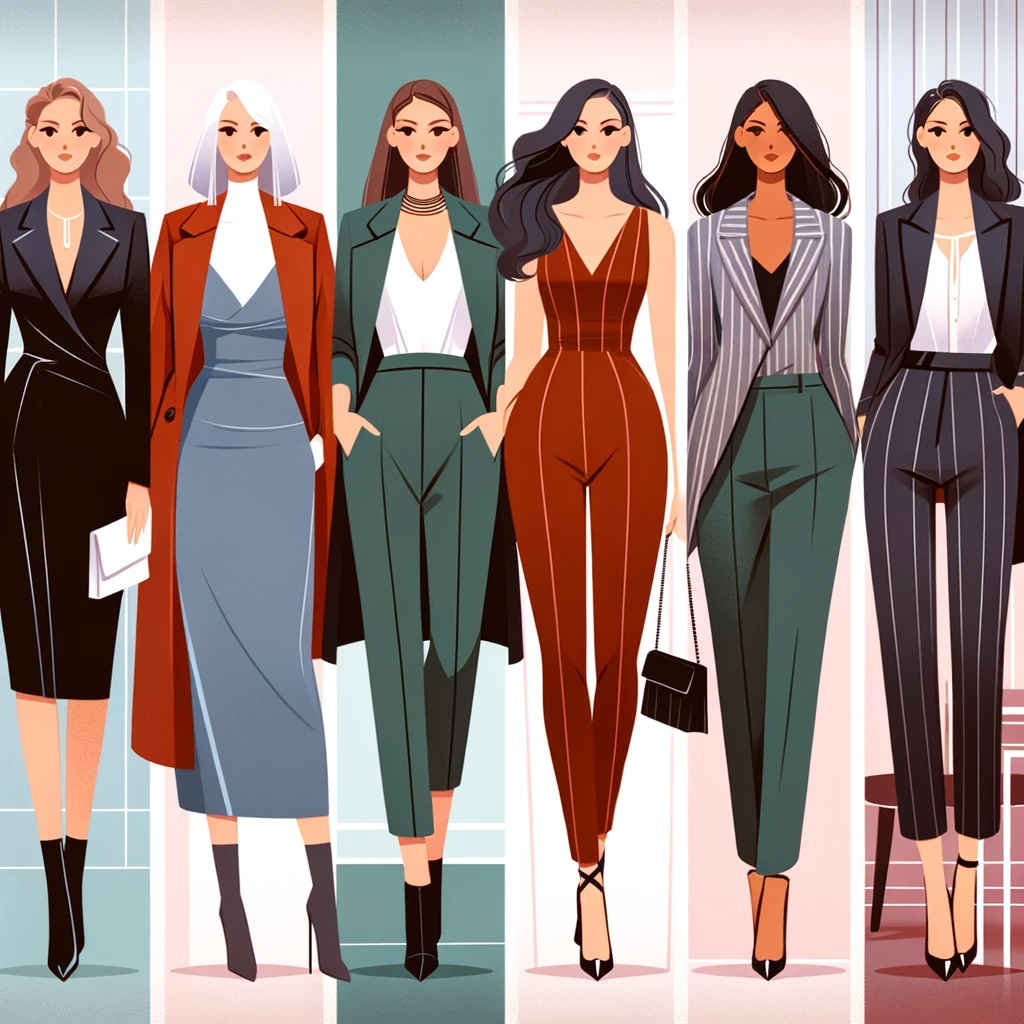In a world brimming with diverse fashion choices, understanding how to dress for your body type stands as a cornerstone of personal style. It’s an empowering skill that goes beyond trends and designer labels, focusing on what makes each individual look and feel their best. The key to this fashion savvy lies not in mimicking what’s on the runway, but in recognizing and celebrating the unique contours of your body.

Why is this important? Because when clothes complement your natural shape, they not only enhance your appearance but also boost your confidence and comfort. It’s like speaking a language where your wardrobe communicates the best version of yourself to the world. Whether you’re an hourglass, pear, apple, rectangle, or inverted triangle, each body type has its own set of flattering styles and fits.
This article is designed to be your guide in this journey of self-discovery and style. We’ll delve into the nuances of different body shapes, offering practical fashion tips that will help you dress in a way that celebrates and accentuates your individuality. Our goal is to empower you with knowledge so that every time you pick an outfit, you feel confident and radiant, knowing it’s the perfect match for your body type.
Understanding Body Types
Fashion is an art that thrives on individuality, and the first step in mastering this art is understanding your canvas – your body. Each body is unique, but generally, they can be categorized into a few common shapes. Recognizing your body type is key to finding clothes that not only fit well but also flatter your natural silhouette.
The Five Common Body Types
Hourglass: Characterized by balanced bust and hip measurements and a well-defined waist. Think of it as a classic, curvaceous figure.

Pear (Triangle): Noticeably wider at the hips than the bust, with a fuller backside and slender upper body.

Apple (Round): Wider around the midsection with a fuller waist, often with slimmer legs and arms.

Rectangle (Straight): The bust, waist, and hip measurements are relatively similar, creating a straight-line effect.

Inverted Triangle: Broad shoulders and bust that taper down to the hips, creating an athletic-looking silhouette.

How to Identify Your Body Type
Measurements: Take measurements of your bust, waist, and hips. Compare these to see which category you align with.
Mirror Test: Stand in front of a mirror in form-fitting clothing or none, and observe the proportions of your bust, waist, and hips.
Fitting Patterns: Notice which types of clothes typically fit you well or feel uncomfortable, as this can also indicate your body type.
Why Knowing Your Body Type Matters
Understanding your body type is more than a step towards stylish dressing; it’s about embracing and accentuating your natural shape. When you know your body type, you can make informed choices that enhance your best features, leading to greater confidence and comfort in your clothes.
Accessorizing for Your Body Type
Accessorizing is an art that can transform your outfit from good to great. It’s not just about what you wear, but how you choose to accentuate it. The right accessories can highlight your best features, and when chosen according to your body type, they can create a balanced and harmonious look. Here’s how to select accessories for different body shapes:
- Hourglass
Belts: Emphasize your naturally defined waist with medium-width belts.
Jewelry: Opt for necklaces that fall just below the bust line to complement your curves.
Shoes: High heels can enhance your leg line and maintain your body’s balance.
- Pear (Triangle)
Scarves and Necklaces: Draw attention upwards with statement necklaces and colorful scarves.
Bags: Choose shoulder bags that sit at your waist to balance your lower half.
Shoes: Wedges or shoes with ankle details can visually balance your hips.
- Apple (Round)
Long Necklaces: Create a more elongated appearance with long, vertical pendants.
Shoes: Opt for shoes with pointed toes and low to medium heels to elongate your legs.
Bags: Go for longer, structured bags that hang lower on the body.
- Rectangle (Straight)
Belts: Use belts to create the illusion of a waist.
Layered Jewelry: Layered necklaces or chunky bracelets add dimension to your outfit.
Shoes: Ankle boots or shoes with embellishments can add interest to your look.
- Inverted Triangle
Bright and Bold Shoes: Draw attention to your lower body with colorful or embellished shoes.
Hoop Earrings and Chokers: These can soften your shoulder line.
Bags: Hip-length bags can add volume to your hips and balance your upper body.
General Tips
Proportion is Key: Make sure the size of your accessories matches your body scale. If you’re petite, avoid oversized bags and jewelry.
Color Contrast: Use accessories to add a pop of color or contrast to your outfit for an eye-catching effect.
Experiment: Don’t be afraid to try different combinations to see what works best for your body type and personal style.
Accessorizing is a powerful tool in your fashion arsenal. With these tips, you can choose accessories that not only complement your body type but also reflect your unique style and personality.
Mix and Match: Creating Balanced Outfits
Mastering the art of mixing and matching clothing items is essential for creating outfits that not only look great but also feel right for your body type. The goal is to achieve a harmonious balance that enhances your natural silhouette and aligns with your personal style. Here are some tips and illustrative examples:
- For the Hourglass Figure
Example: Combine a fitted blouse tucked into a high-waisted pencil skirt. Add a belt at the waist to accentuate your natural curves. Finish with a pair of classic pumps.
Why It Works: This outfit maintains the natural balance of the hourglass figure while highlighting the waist.
- For the Pear Shape
Example: Pair a light-colored boat-neck top with dark, wide-legged trousers. Accessorize with a statement necklace and heeled ankle boots.
Why It Works: The wide neckline and statement necklace draw attention upwards, while the wide-legged trousers balance the wider hips.
- For the Apple Shape
Example: Opt for a flowy, patterned tunic top over slim-fit jeans. Complete the look with a long pendant necklace and ballet flats.
Why It Works: The tunic offers coverage while the slim-fit jeans create a streamlined look for the legs.
- For the Rectangle Shape
Example: Try a layered look with a fitted top under a cardigan, coupled with a flared skirt. Use a thin belt to create a waistline.
Why It Works: The belt cinches the waist, and the flared skirt adds curves to the straight silhouette.
- For the Inverted Triangle Shape
Example: Match a simple V-neck top with an A-line skirt. Add some strappy sandals for a chic look.
Why It Works: The A-line skirt adds volume to the lower body, balancing the broader shoulders.
General Mixing and Matching Tips
Play with Textures and Patterns: Mixing textures and patterns can add depth to your outfit. Just make sure to keep them in the same color palette for cohesion.
Balance Loose and Tight: Pairing a loose top with tight bottoms, or vice versa, can create a pleasing balance.
Layering: Smart layering can help create dimension and structure in your outfit. For example, adding a blazer or jacket can define your silhouette.
By understanding these mix-and-match principles, you can create outfits that are not only stylish but also tailored to flatter your body type. Remember, the key to great style is wearing your clothes with confidence!
FAQs: Fashion Tips for Different Body Types
What are the different body types?
There are generally five main body types: Hourglass, Pear (Triangle), Apple (Round), Rectangle (Straight), and Inverted Triangle.
How do I determine my body type?
Measure your bust, waist, and hips. Compare these measurements and observe your body’s proportions in a mirror to identify your body type.
Can my body type change over time?
Yes, body types can change due to factors like weight fluctuations, aging, and lifestyle changes.
What are the best styles for an Hourglass figure?
Fitted clothes that cinch at the waist, like wrap dresses and belted tops, work well for Hourglass figures.
What should Pear body types avoid wearing?
Pear body types might avoid clothing that overly emphasizes the hips, like cargo pants or low-waisted trousers.
How should someone with an Apple body type dress?
Opt for clothing that elongates the torso, like V-neck tops, and creates a more balanced silhouette with A-line skirts or structured pants.
Are there specific fabrics that work better for certain body types?
Yes, for example, stiffer fabrics can add structure to Rectangle body types, while stretchy, flowing fabrics suit Hourglass and Pear shapes well.
What kind of jackets should an Inverted Triangle body type choose?
Jackets that are tailored at the waist and flare at the hips can balance broader shoulders.
Can Rectangle body types wear patterns?
Absolutely, patterns can add interest and dimension, especially around the bust and hips to create the illusion of curves.
What type of dresses is best for an Hourglass figure?
Dresses that are fitted at the waist and follow the natural curve of the body, like sheath dresses, are ideal for Hourglass figures.
How can Pear body types balance their silhouette?
Wearing darker colors on the bottom and brighter or detailed tops can draw attention upwards and balance the silhouette.
What are the best tops for an Apple body type?
Tops with an empire waist or those that flow away from the body can be flattering for Apple body types.
Should Inverted Triangle body types avoid shoulder pads?
Generally, yes, as shoulder pads can make the shoulders appear broader.
What are the best skirts for a Rectangle body type?
Full skirts, circle skirts, or those with ruffles can add curves to a Rectangle body type.
How important are accessories in dressing for my body type?
Very important. Accessories like belts, scarves, and jewelry can significantly enhance an outfit and highlight your best features.
Can fashion rules for body types be broken?
Absolutely, these guidelines are just that – guidelines. Personal style and comfort are the most important.
Are there any universal fashion tips that work for all body types?
Yes, dressing in a single color can create a unified, elongating effect, and well-tailored clothes usually look flattering on everyone.








